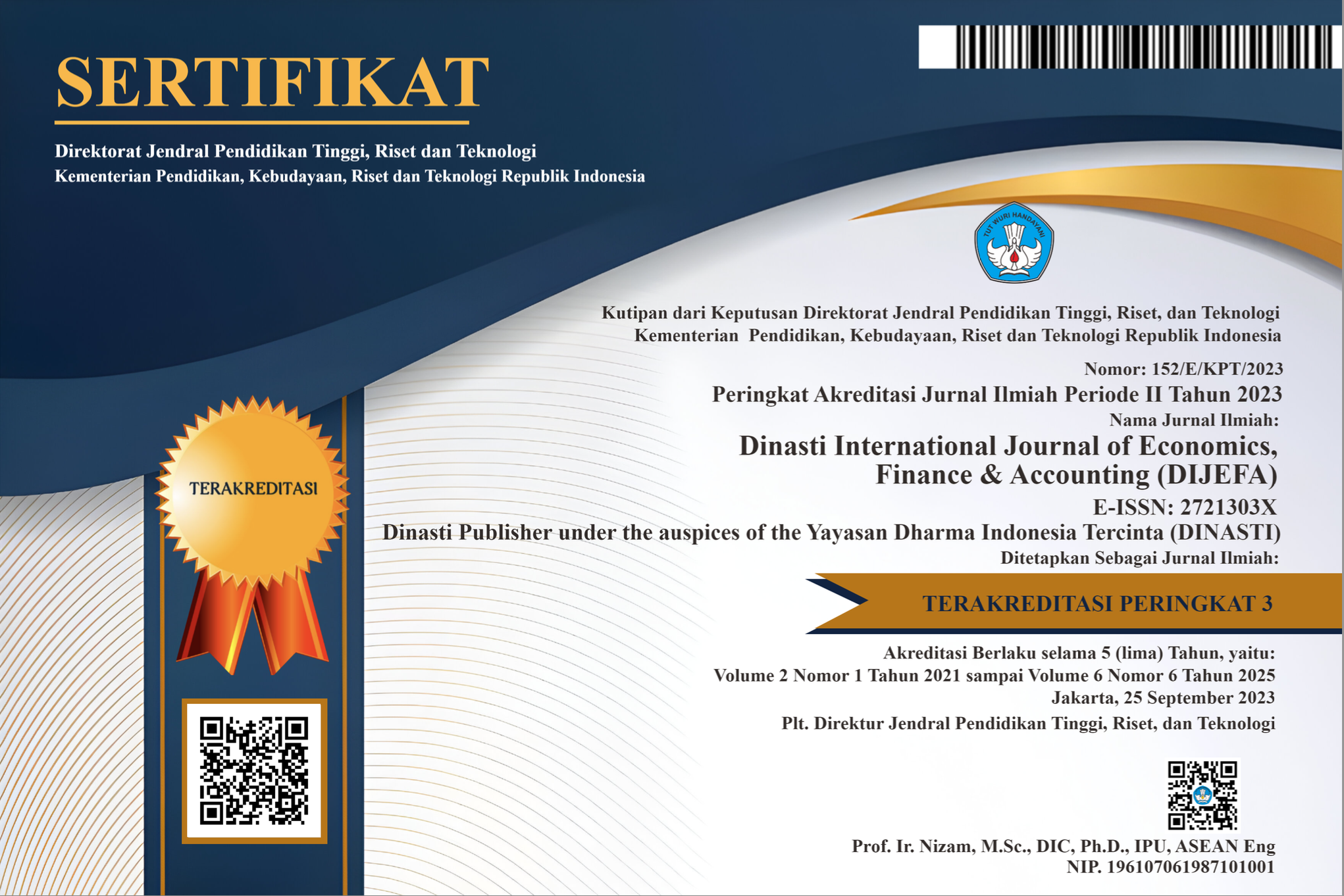The Role of Leading Sectors and Balancing Funds in Reducing Poverty and Improving the Welfare in the Papuaprovince
DOI:
https://doi.org/10.38035/dijefa.v5i1.2418Keywords:
leading sectors, balancing funds, poverty, welfareAbstract
This research investigates the role of the primary sector and balancing funds in efforts to reduce poverty and enhance the welfare of the population in the Province of Papua, utilizing a panel data analysis approach. The data utilized spanned from 2018 to 2021, encompassing 29 regencies/cities in the Province of Papua. The data were obtained from the Papua Province Central Statistics Agency and the Directorate General of Fiscal Balance, Ministry of Finance of the Republic of Indonesia, which was collected using documentation techniques. The results of our analysis reveal significant findings. First, it was found that leading sectors, general allocation funds and revenue sharing funds have a significant impact in reducing poverty levels in this region. Second, poverty also has a significant influence on the welfare of the population. Furthermore, our research results also show that leading sectors, general allocation funds and revenue sharing funds have a significant impact in improving the welfare of the population directly, but not significantly through poverty.
References
Abdillah, F., & Wahyudi, M. S. (2021). The Effect of Health Expenditure, Balance Fund, and Poor Population on Human Development Index in West Papua Province. Journal of Economics JIE, 5(4), 738-750. https://doi.org/10.22219/jie.v5i04.19450
Agustina, T., & Pamungkas, L. A. (2021). Leading Sector Analysis in East Belitung Regency. Equity: Journal of Economics, 9(2), 30-38. https://doi.org/https://doi.org/10.33019/equity.v9i2.57
Ayomi, S. (2013). Analysis of the Effect of Main Sector Growth on Poverty Level, Unemployment Rate, and Human Development Index (HDI) in the Madiun Development Area Unit and its Surroundings 2003-2012. Scientific Journal of FEB Students, Universitas Brawijaya, 2(2).
Regional Development Planning Agency of Papua Province. (2019). Regional Medium-Term Development Plan of Papua Province 2019-2023. Regional Development Planning Agency of Papua Province.
Central Bureau of Statistics. (2022). Human Development Index 2022. In Central Bureau of Statistics. Jakarta: Central Bureau of Statistics.
Central Bureau of Statistics of Papua Province. (2022). Papua Province in Figures 2022. Jayapura: Central Bureau of Statistics of Papua Province.
Bakar, A. (2017). Identification of Leading Economic Sectors in Mimika Regency, Papua Province. JOURNAL KRITIS (Policy, Research and Innovation), 1(2), 1-26.
Bjornestad, L. (2009). ADB Economics Working Paper Series. Fiscal Decentralization, Fiscal Incentives, and Pro-Poor Outcomes: Evidence from Viet Nam. In Asian Development Bank (Issue 168).
Budiani, S. R., Santi, D. I., Rokhim, A. A., Puspaningrani, F. C., Kurniasari, K., Probowati, H., Ramdani, H. P., Rafif, M., & Hilmi, Z. (2022). Analysis of the Relationship between the Leading Sector of Processing Industry and HDI of Kendal Regency in 2010-2019. Indonesian Geography Magazine, 36(1), 10. https://doi.org/10.22146/mgi.63158
Burchi, F., & De Muro, P. (2016). Measuring Human Development in a High-Income Country: A Conceptual Framework for Well-being Indicators. Forum for Social Economics, 45(2-3), 120-138. https://doi.org/10.1080/07360932.2014.995196
Chairunnisa, & Gunarto, T. (2023). The Effect of Per Capita Non-Food Expenditure, Poverty Level, and Women as Professional Personnel on HDI in Lampung Province for the 2017-2021 Period. Journal on Education, 06(01), 7350-7358.
Dewantara, Y. F., & Susanto, P. (2020). Analysis of Positive Impacts on Welfare and Economic Growth in Implementing the Tourism Village Concept in Batulayang Village, Bogor Regency. Destinesia: Journal of Hospitality and Tourism, 2(1), 9-19. https://doi.org/10.31334/jd.v2i1.1067
Dick-sagoe, C. (2020). Decentralization for Improving the Provision of Public Services in Developing Countries: A critical review. Cogent Economics & Finance, 8(1). https://doi.org/10.1080/23322039.2020.1804036
Febrianti, L. (2022). Analysis of the Effect of Regional Original Revenue, Balance Funds and Gross Regional Domestic Product on the Human Development Index in West Nusa Tenggara Province. Indonesian Journal of Economics and Business, 7(1), 19-26. https://doi.org/10.37673/jebi.v7i1.1992
Gordon, D. (2006). The Concept and Measurement of Poverty. In Poverty and Social Exclusion in Britain. Bristol: Policy Press.
Gujarati, D. N. (2003). Basic Econometrics. In The Economic Journal (Fourth Edi, Vol. 82, Issue 326). New York: The McGraw-Hili Companies, Inc. https://doi.org/10.2307/2230043
Hick, R. (2013). Poverty, Preference or Pensioners? Measuring Material Deprivation in the UK. Fiscal Studies, 34(1), 31-54. https://doi.org/10.1111/j.1475-5890.2013.00176.x
Jayadi, D. S., & Brata, A. G. (2016). The Role of Economic Growth in Reducing Poverty at the Provincial Level in Indonesia in 2004-2012. Modus, 28(1), 91. https://doi.org/10.24002/modus.v28i1.669
Juhanis. (2012). The Influence of Leading Sectors on Economic Growth in South Halmahera Regency. Journal of Plano Madani, I(1), 16-28.
Kadafi, M., & Murtala, M. (2020). The Effect of Local Revenue, General Allocation Fund and Special Autonomy Fund on Poverty Level in Aceh Province for the Period 2010-2017. Unimal Journal of Regional Economics, 3(2), 23. https://doi.org/10.29103/jeru.v3i2.3203
Khikmah, Z., Sarfiah, S. N., & Prasetyanto, P. K. (2018). The Effect of Poverty, Economic Growth and Capital Expenditure on HDI in Sulawesi Island in 2011-2018. DINAMIC: Directory Journal of Economic, 2(4), 1127-1142. https://doi.org/https://doi.org/10.31002/dinamic.v2i4.1449
Kosmaryati, K., Handayani, C. A., Isfahani, R. N., & Widodo, E. (2019). Factors Affecting Criminality in Indonesia in 2011-2016 with Panel Data Regression. Indonesian Journal of Applied Statistics, 2(1), 10. https://doi.org/10.13057/ijas.v2i1.27932
Lahama, Andrew., Rengkung, L. R., & Ruauw, E. . (2018). Analysis of Leading Sectors in Labor Absorption in South Minahasa Regency. Agri-Socioeconomics, 14(2), 205-214. https://doi.org/10.35791/agrsosek.14.2.2018.20584
Luthfianto, P. K. (2023). Analysis of the Role of Leading Sectors on Economic Growth in Ponorogo Regency, East Java Province. Journal of Indonesian Impression, 2(1), 16-22. https://doi.org/10.58344/jii.v2i1.2051
Masruri, F. (2022). Economic Competitiveness Analysis of Papua Province in 2011-2018 (Case Study of Regency / City in Papua Province). Scientific Journal of FEB Students, Universitas Brawijaya, 8(2).
Meilena, E., & Wahed, M. (2023). Analysis of Leading Sector Determination on Economic Growth in Bangkalan Regency. JEMSI (Journal of Economics, Management, and Accounting), 9(4), 1284-1297. https://doi.org/10.35870/jemsi.v9i4.1282
Moedjiono, E. J., Londa, A. T., & Tumangkeng, S. Y. L. (2021). Analysis of Leading Economic Sectors for Economic Growth in Bitung City. Journal of Efficiency Scientific Periodicals, 21(4), 91-99.
Nany, M., Pratama, D. B., Prasetyaningrum, M., & ... (2022). The Effect of PAD, DBH, DAU, DAK and Regional Expenditure on Poverty in Central Java. Journal of Economics ..., 22(3), 247-261.
Nasir, M. (2017). Analysis of the Effect of Economic Sectors Having LQ Values Greater than One on Improving the Welfare of City Communities in North Sumetara. EKONOMIKAWAN Journal of Economics and Development Studies, 17(1), 71-86. https://doi.org/https://doi.org/10.30596/ekonomikawan.v17i1.1182
Nila Isroviyah. (2020). Analysis of the Effect of Education and Health on Poverty in Indonesia 2016-2020. Scientific Journal of FEB Students, Universitas Brawijaya, 10(2), 1-23.
Ningsih, I. R., & Kara, M. (2023). The Effect of Government Expenditure on Health, Education and Inflation on the Human Development Index and Poverty in South Sulawesi. ICOR: Journal of Regional Economics, 4(1), 40-54.
Oates, W. (1972). Fiscal Federalism. Harcourt Brace.
Panggabean, H. L., Hariani, D., & B, A. Y. (2022). The Effect of General Allocation Fund, Regional Original Revenue and Special Allocation Fund on Poverty with Economic Growth as Intervening Variable in 2015-2019. Owner, 6(2), 2200-2208. https://doi.org/10.33395/owner.v6i2.836
Ponto, M., Kalangi, J. B., & Luntungan, A. Y. (2015). Analysis of the Determination of the Leading Sector of the Economy towards Labor Absorption in Jayapura City. Journal of Efficiency Scientific Periodicals, 15(2), 1-20.
Pratama, F. B., Djohan, S., & Kustiawan, A. (2021). The Effect of Leading Sectors on Labor Absorption in Samarinda City. Journal of Mulawarman Economics (JIEM), 6(2). https://doi.org/https://doi.org/10.29264/jiem.v6i2.8991
Puspita, D., Pahlevi, M., Raharja, Y. M., Hadi, S., Baroto, L. A., Permana, A. W., & Rahayu, W. T. (2021). Two Decades of Fiscal Decentralization Implementation in Indonesia. Fiscal Policy Agency of the Ministry of Finance of the Republic of Indonesia.
Putra, P. P. M. E., & Dewi, M. H. U. (2018). The Influence of PAD and Balance Fund on Capital Expenditure and Community Welfare of Karangasem Regency, Bali Province. E-Journal of Development Economics, Udayana University, 7(10), 2163-2189.
Putri, G. T. L., & Cahyono, H. (2021). Independent: Journal Of Economics E-ISSN: 2798-5008. Independent: Journal Of Economics, 1(1), 14-29.
Qubro, G., Muljaningsih, S., & Asmara, K. (2021). The Influence of Leading Sectors on Economic Growth in Banyuwangi Regency. Journal of Syntax Admiration, 2(8), 1444-1452. https://doi.org/10.46799/jsa.v2i8.298
Rajab, A., & Rusli. (2019). Determination of Leading Sectors in Takalar Regency through Klassen Typology Analysis. GROWTH Scientific Journal of Development Economics, 1(1), 16-38.
Rasu, K. J., Kumenaung, A. G., & Koleangan, R. A.. (2019). Analysis of the Effect of Special Allocation Fund, Regional Original Revenue, General Allocation Fund and Revenue Sharing Fund on Poverty Level in Manado City. Journal of Economic Development and Regional Finance, 20(2), 1. https://doi.org/10.35794/jpekd.23843.20.2.2019
Ravallion, M. (2010). Poverty Lines across the World. In Policy Research Working Paper 5284 (April Issue). https://doi.org/10.1093/oxfordhb/9780195393781.013.0004
Riani, I. A. P., & Pudjihardjo, M. (2012). Analysis of the Impact of Regional Expansion on Per Capita Income, Poverty and Interregional Inequality in Papua Province. Jurnal Bumi Lestari, 12(1), 137-148.
Suhendi, S., & Astuti, I. P. (2023). Analysis of the Effect of Poverty Level, GRDP and Government Expenditure on Health and Education on HDI in Papua Province in 2017-2022. Scientific Journal of Management, Economics, & Accounting (MEA), 7(2), 1676-1694. https://doi.org/10.31955/mea.v7i2.3212
Sumule, A. I., A., D. S., Suratman, E., Lang, H. C., Bauw, L., Siddik, M., Tuerah, N., Nurkholis, & Reba, W. H. (2019). Study on Utilization of Special Autonomy Funds for Papua and West Papua 2002 - 2018. Jakarta: Compact.
Suratman, E. (2017). Policy Notes: Fund Transfers and Regional Disparities. In KOMPAK (Kolaborasi Masyarakat dan Pelayanan untuk Kesejahteraan) (September Issue). Jakarta: KOMPAK (Kolaborasi Masyarakat dan Pelayanan untuk Kesejahteraan).
Syarifuddin, T., & Zulham, T. (2018). Leading Sector Analysis and Its Effect on Economic Growth in Nagan Raya District, Aceh Province. Scientific Journal of Development Economics Students, 3(4), 844-851.
Trismayanti, M. (2023). Leading Sector Analysis in Poverty Alleviation Efforts in Kuningan Regency. UBS Journal of Economics and Business, 12(1), 792-805.
Trisno, T. U., Munajat, & Oktarina, Y. (2022). The Effect of Poverty on the Human Development Index (HDI) in South Sumatra Province 2016-2020. Fair Value: Scientific Journal of Accounting and Finance, 4(8), 3560-3566. https://doi.org/10.53488/jba.v7i02.128
Uar, A., & Madubun, H. (2021). Development Strategy of Leading Sectors in Regional Economic Development of Southeast Maluku Regency. Hypothesis, 15(1), 34-49.
Udiarto, A. K. (2015). Characteristics of Regional Development Before and After the Expansion of Jayapura Regency. Journal of Region and Environment, 3(2), 121. https://doi.org/10.14710/jwl.3.2.121-130
Vikash, V. (2019). Human Development Index and Gross National Happiness Indices: A Conceptual Study. Advances In Management, 12(1), 62-63. https://www.worldresearchersassociations.com/mngmntcurrissue/10.pdf
Wang, Z., & Ma, L. (2014). Fiscal Decentralization in China: A Literature Review*. Annals of Economics and Finance, 15(2), 751-770.
Wardani, N. K. (2018). The Effect of Regional Assets, PAD, Balance Funds, and Capital Expenditures on the Human Development Index (Empirical Study of Regency and City Regional Governments in Central Java Province in 2014-2016). Accounting Study Program, Faculty of Economics and Business, Universitas Muhammadiyah Surakarta.
Widodo, S., & Zakiah, K. (2022). The Effect of Balancing Funds and Regional Capital Expenditures on HDI, TPT, TPAK and the Percentage of Poor Population. Journal of Budget, 7(2), 277-297. https://doi.org/10.31092/jpkn.v1i2.793
Yang, L. (2017). The Relationship between Poverty and Inequality: Concepts and Measurement. In CASEpaper 205/LIPpaper 2 (Vol. 205, Issue 2).
Downloads
Published
How to Cite
Issue
Section
License
Copyright (c) 2024 Abu Bakar

This work is licensed under a Creative Commons Attribution 4.0 International License.
Authors who publish their manuscripts in this journal agree to the following conditions:
- The copyright on each article belongs to the author(s).
- The author acknowledges that the Dinasti International Journal of Economics, Finance & Accounting (DIJEFA) has the right to be the first to publish with a Creative Commons Attribution 4.0 International license (Attribution 4.0 International (CC BY 4.0).
- Authors can submit articles separately, arrange for the non-exclusive distribution of manuscripts that have been published in this journal into other versions (e.g., sent to the author's institutional repository, publication into books, etc.), by acknowledging that the manuscript has been published for the first time in the Dinasti International Journal of Economics, Finance & Accounting (DIJEFA).


























































